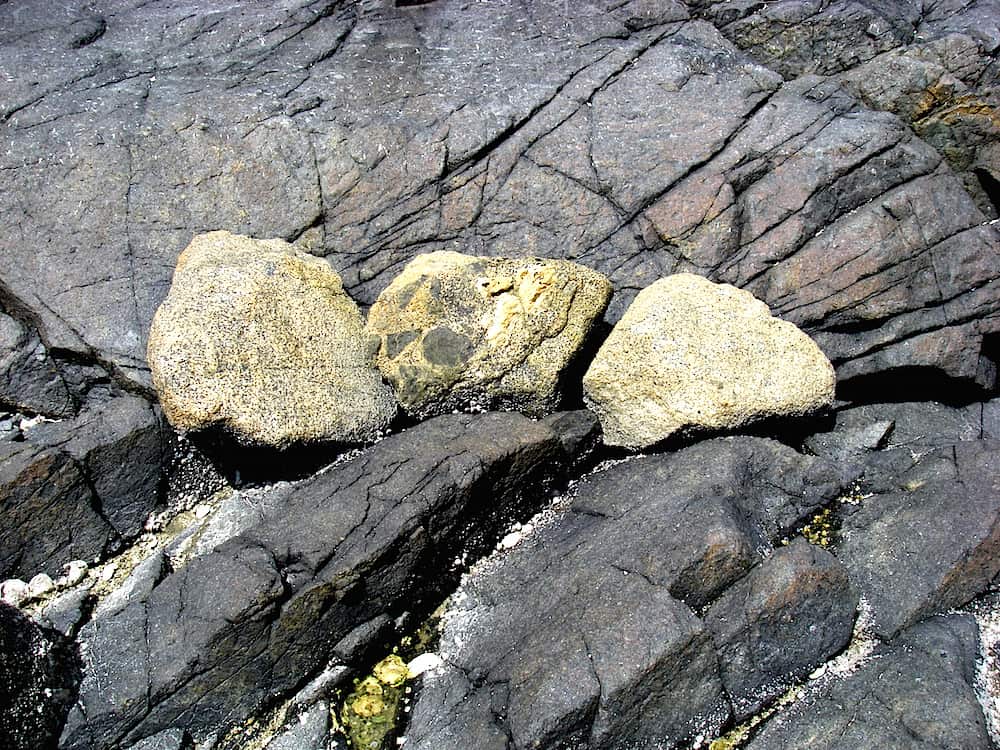A Brief Survey of Cortes Island Beach Rocks
DEFINITION: erratic (er-rat’-ic) n. A rock fragment carried by glacial ice, or by floating ice, deposited at some distance from the outcrop from which it was derived, and generally though not necessarily resting on bedrock of different lithology. Size ranges from a pebble to a house-size block.
Bates & Jackson, Glossary of Geology

A WALK ON THE BEACH
Exercising our sense of balance and improving our core body-strength, we all have struggled across the impressive boulder fields that make up most of our local beaches. How many of us have marvelled at the great variety of rock types, at their roundedness and at the peculiar patterns of their distribution?
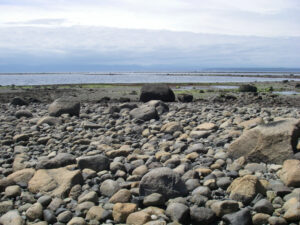
With very few exceptions, all these rocks fall within the definition of erratics. Here and there, a cliff-face has crumbled and dropped its angular pieces of broken stone at its base. The nearby origin of these fragments is easily discerned. All other loose rocks in our area have been transported by the glaciers of the last Ice Age, finding their final resting place when the last of the glaciers melted not much longer than 10,000 years ago.
Occasionally, glacial scratch-marks (striae) can be seen on the surface of erratics as if to prove their Ice Age provenance (Fig.3).

One of the tasks of a glaciologist is the determination of where erratics originated, what route and how far they have travelled. It is not uncommon for rocks to have been transported over distances of hundreds, even in excess of 1000 kilometres. A rule of thumb states that the rounder a rock is, the farther it has travelled, but there are exceptions.
Fjords, like Bute and Toba Inlets, represent glacial highways, along which vast masses of rock have travelled all the way from the crestlines of the Pacific Range of the Coast Mountains.
The Homathko River, draining into Bute, originates in Tatlayoko Lake, which is about 175 km from Cortes Island – as the crow flies. Lake, river and fjord mark the path of the great Bute glacier that flowed all the way to and across Cortes Island, where it was met by a similar if somewhat smaller glacier coming out of Toba. Both brought with them their loads of rocks, scraped up along their way and carried to where the ice flow eventually stopped, and the tumbled, abraded and rounded boulders, cobbles and pebbles were deposited.
Rocks from all across the Coast Mountains have been moved to Cortes Island this way, and nowhere are they better exposed than along the coastline, where wave action has removed sand and mud (“winnowed out the fines”, as the lingo goes) and exposed a true smörgåsbord of different lithologies.
One of the characteristics of our coastal mountains is the fact that they are made up from a number of so-called Terranes, each of which has its own history of formation and travel: originating as island arcs, which formed hundreds of millions of years ago in the Proto-Pacific, these mini-continents drifted on their tectonic plates to where they eventually collided with and accreted to the ancient North American continent (called Laurentia), enlarging it in the process considerably. These continental collisions did not only result in roughly parallel zones of distinct geologies, their violence also caused volcanism and a variety of metamorphic processes, all of which added to the perplexing complexity of both structure and rock types to be found in BC’s coast mountain ranges.
Many of the erratics that ended up on Cortes Island’s beaches originated in the so-called metamorphic belt of the Coast Mountains. Rocks with exotic names like Garnet Gneiss or Chiastolite Schist (Figs. 4 and 5). They stand out as clearly different from the common granitic bedrock we are all familiar with.
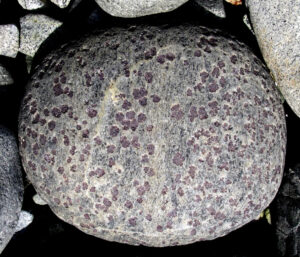
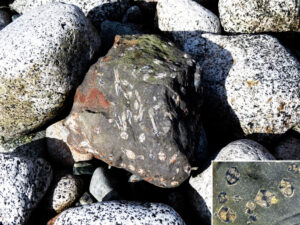
Among the most interesting and somewhat mysterious erratics are the 60-odd fossil-bearing sedimentary rock samples that are listed with the Cortes Island Museum (see ring-book “Granite and Fossils”). A few examples are permanently displayed on the museum’s porch. What makes these rocks so intriguing is the fact that no provenance has yet been assigned to them: we don’t know where they come from.
They are all Sandstone, albeit of varying hardness, density and colour, and their fossil content consists almost exclusively of accumulations of Late Cretaceous (130 million years old) clams, belonging in the genus Buchia.
Here are a few examples (Figs. 6, 7, 8).

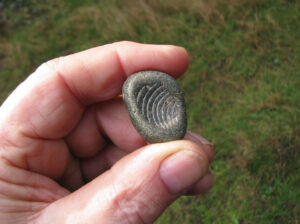

Unusual erratics are noticed on Cortes Island by many observant beach-walkers all the time. The author, on behalf of the Cortes Museum, wishes to encourage any and all to report such findings (edgeswamp@gmail.com), so that they can be properly documented.
Not long ago, Eli McKenty brought an interesting volcanic rock for inspection (Fig.9): a well-rounded chunk of Amygdaloidal Basalt (another one of those grandiose names), which is a piece of lava with lots of conspicuous vesicles, i.e. bubbly lava that cooled and hardened rapidly, trapping gas inside the rock. Coastal volcanism, caused by the continuing subduction of the Juan de Fuca Plate, was active very recently, so this specimen could be quite young.
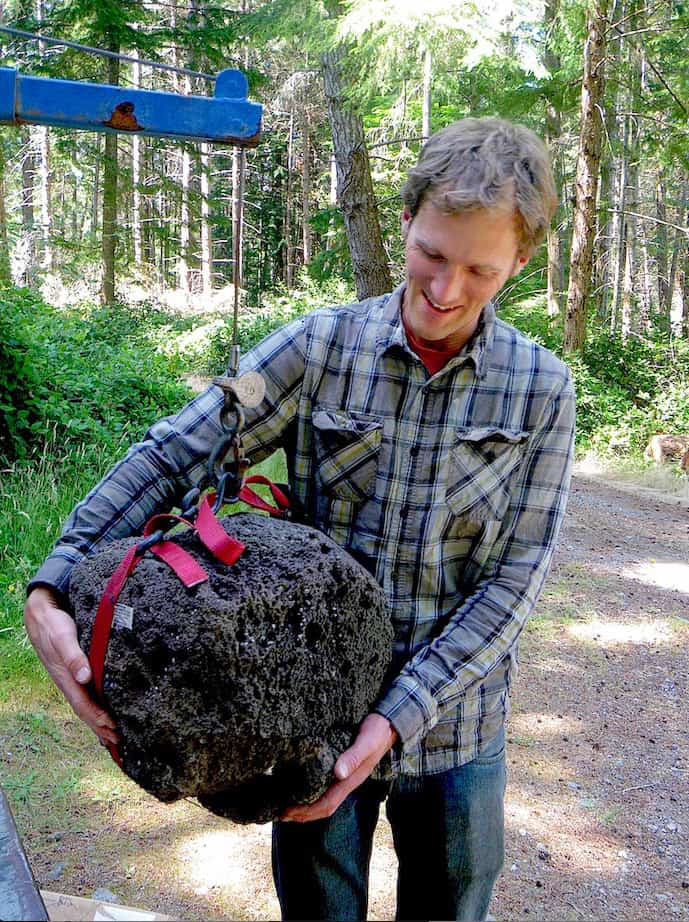
Actually, to be nigglingly and pedantically correct, Eli’s rock should be referred to as Vesicular Basalt, since the many bubbles that permeate it are open and hollow. The technically accurate application of the term amygdaloidal would be to a rock like the one in Fig.9a.
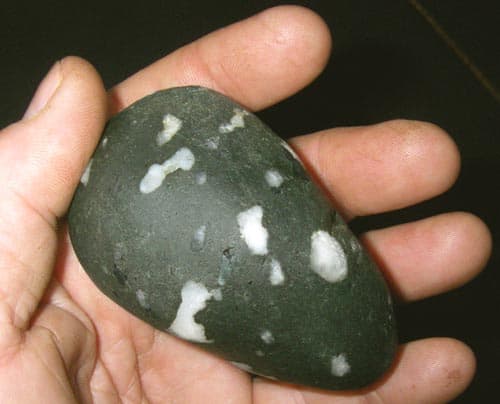
“Amygdaloidal” is an irresistibly nerdy word, but it has an almost plausible origin: ancient Greek ἀμυγδάλη (amugdalē, “almond”). So anything almond-shaped can be referred to as amygdaloidal – and, as an aside, that includes that little reptilian lump close to our human brainstem, called the Amygdala. Perhaps those mineral-filled vesicles of the Karmutsen Basalt qualify as “almond-shaped”, perhaps not, the term applies nonetheless. The mineral, incidentally, is called Prehnite, and it indicates that the rock at some point in its history was subjected to low levels of metamorphic heat and pressure.
One more example of a thoroughly exotic looking boulder, located not far from Sutil Point, Cortes Island (Fig.10).

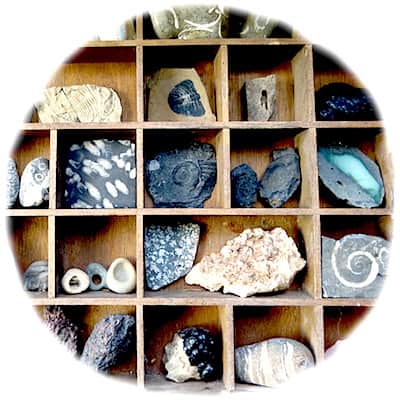
To paraphrase Robert Louis Stevenson:
“It is perhaps a more fortunate destiny to have a taste for collecting rocks
than to be born a millionaire.”

